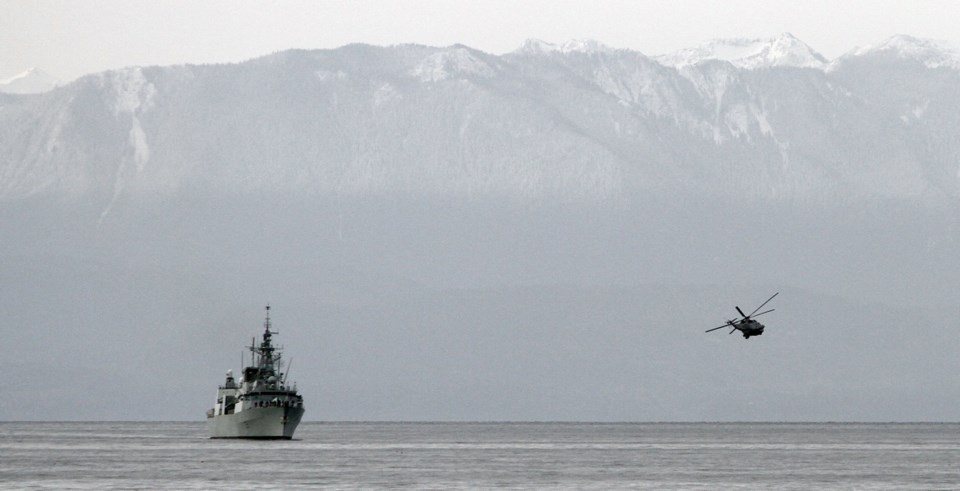Canada’s West Coast navy doesn’t do much shooting.
HMCS Regina accidentally declared war on Pete’s Tent and Awning in View Royal in 1996, blowing apart a storage shed with an unarmed 20-kilogram chaff rocket that sailed three kilometres across the harbour when something went sideways in a training exercise.
Back in 1962, HMCS Skeena fired 16 three-inch shells into the area of Clallam Bay, Wash., across the strait from Jordan River, during a gunnery exercise. We can count ourselves lucky that A) no one was hurt and B) the Americans didn’t nuke us back.
The point, gratuitous schadenfreude aside, is that ours has long been a peacetime navy — and peacetime militaries don’t get a lot of love from their governments, which tend to treat them as fire departments with no fires to fight (right up until the house erupts in flames). Funding for new equipment disappears.
Here’s the dilemma: We are now at the point, as we discovered this week, where knocking just a couple of ships out of the rotation threatens the fleet’s ability to function. Yet replacing them is staggeringly expensive. The hundreds of millions spent refurbishing existing vessels pales beside the tens of billions it will take to build new ones.
Considering we have the longest coastline in the world, Canada’s is a pretty small navy: 12 frigates, a dozen little coastal patrol vessels, three aging destroyers, two 44-year-old supply ships and four second-hand, trouble-plagued submarines. (Contrast the size of today’s fleet to that at the end of the Second World War, when the Royal Canadian Navy was the third- or fourth-largest in the world with — depending how you count them — roughly 400 ships.)
Two years ago, the federal government announced a massive replacement program: $25 billion worth of combat ships to be built on the East Coast by 2041, and $8 billion for five Coast Guard vessels and two or three navy resupply ships to be built in Vancouver and Victoria.
The newest of the new warships are still years away, though, so cross your fingers that nothing else goes wrong for the navy. With three of CFB Esquimalt’s vessels in the shop this week, Canada was left with just six large ships — four frigates and two subs — to cover the entire Pacific.
Repairs on frigate HMCS Winnipeg, rammed by an out-of-control American trawler while tied up in Esquimalt in April, will continue until the end of the year. Destroyer HMCS Algonquin, badly gouged in a collision with supply ship HMCS Protecteur a week ago, is out indefinitely.
The good news is Protecteur has already been repaired and is due to return to sea next week. (The bad news, at least for the crew, is that instead of going to Hawaii as scheduled, Protecteur will join five other Esquimalt-based ships in an exercise off the North America coast in October and November. Don’t worry, sailors, Klemtu is lovely this time of year.)
The question now is: When will the long-promised replacements for Protecteur and Canada’s other refuelling ship, HMCS Provider, arrive? They fill a critical role.
Construction of the supply ships was announced by the Conservatives in 2006, put on the back burner, then included in the 2011 package. A design was chosen in June. A decision on which to build first, the supply ships or a polar icebreaker, is due to be made this fall — though three other other vessels are first in the West Coast queue in any case.
Vancouver-area MP Joyce Murray, the Liberal party’s defence critic, is suspicious of a Conservative government she says has announced a lot of military hardware without accomplishing much to date. “They have done a lot of posturing, but they have delivered very little.”
Meanwhile, the price tag for big-ticket items such as F-35s and Sea King replacements keeps climbing.
“There’s a whole laundry list of items that are not on time, not on budget and it’s not clear whether they are real or not,” Murray said.
Note that in February, federal budget watchdog Kevin Page warned that although the budget for the supply ships is $2.6 billion, the real cost should be pegged at $4.1 billion, with the possibility that it could rise to $6.3 billion before the ships are ready in 2018-19. For perspective, that last number is more than the B.C. government spends on K-12 education in a year.
The cost of building these ships is massive. The cost of not building is incalculable.



